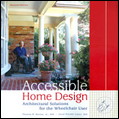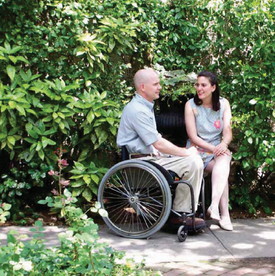 Accessible walks or paths should interconnect your outdoor spaces. This walk is constructed of mortared paving bricks set in a running bond pattern. Whenever possible, the path slope should not exceed a 5 percent incline, and the width should be generous to allow for wheelchair maneuvering. |
Function and aesthetics should guide the design of exterior spaces. For wheelchair users, this means accessible transitions from inside to outside and accessible paths between outdoor locations.
A path that is accessible to some wheelchair users can be inaccessible to others, so slope and surface materials are important considerations. For example, some wheelchair users can roll though short grass if the ground surface is flat and firm. Others cannot because of differences in their personal capabilities and wheelchairs. Loose gravel paths are inaccessible to all wheelchair users and to most people who utilize assistive devices for mobility.
Paths made of wood decking, brick pavers, flagstone, or concrete work best for accessibility.
Copyright Paralyzed Veterans of America
 |
For more in-depth information on making your home accessible, follow this link to purchase the PVA’s second edition of Accessible Home Design: Architectural Solutions for the Wheelchair User or buy it directly from Amazon.




























